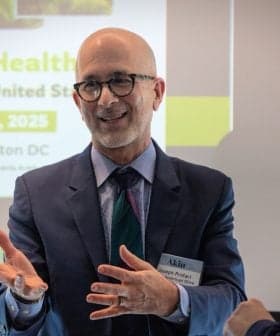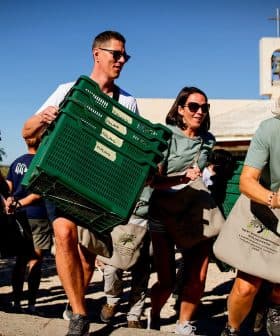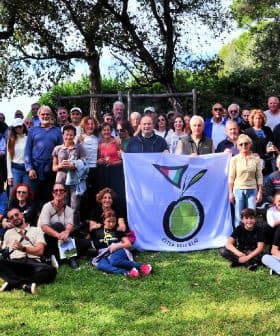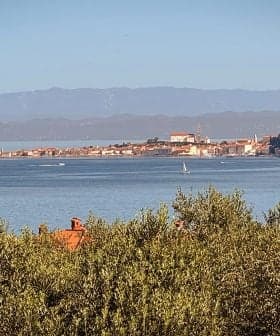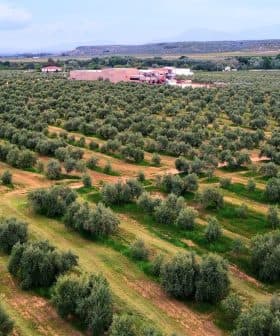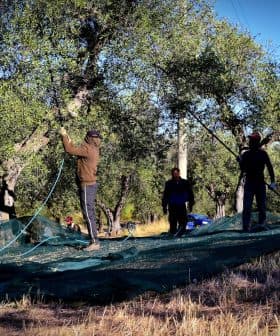Olive Growers on Evia Island Strive to Revive Fire-Damaged Groves
Some say government assistance is lagging behind efforts to bring new life to Evia’s wildfire-ravaged olive groves.
 The aftermath of the wildfires in Evia Island, one of the largest environmental disasters in the country. (Photo: Associated Press)
The aftermath of the wildfires in Evia Island, one of the largest environmental disasters in the country. (Photo: Associated Press) In August 2021, devastating fires swept through Greece, including the north of Evia Island, destroying around 50,000 hectares of forest and agricultural land. Despite promises of state aid, farmers in northern Evia are struggling to restore their olive groves, with many facing delays in receiving compensation and uncertain futures for their livelihoods.
In August 2021, dozens of catastrophic fires burned across Greece, including the north of Evia Island in the Aegean Sea.
Evia, the second-largest island in the country after Crete, runs parallel with central Greece to the east, lying only a few kilometers off the mainland.
Reviving the destroyed olive groves is a herculean task. It takes planting lots of young olive trees and requires tons of water for irrigation. And a lot of labor, of course.
Around 50,000 hectares of forest and agricultural land were ravaged by the wildfires on the island 18 months ago. In the affected areas, the flames consumed thousands of olive trees.
After the disaster, farmers and millers in northern Evia grappled with restoring their livelihoods on the burned land.
See Also:Researchers Predict More Intense Wildfires in Europe“Reviving the destroyed olive groves is a herculean task,” Dimitris Papanastasiou, an olive mill owner based in the coastal village of Oreoi, told Olive Oil Times. “It takes planting lots of young olive trees and requires tons of water for irrigation. And a lot of labor, of course.”
“Almost 80 percent of the olive groves in our area were burned in 2021,” he added. “However, the promised state aid has seriously lagged, and struggling olive farmers have few resources to put into reviving their groves.”
“The state handed out some money after the fire, but not all olive growers have received it yet,” Papanastasiou continued. “Even more, the reconstruction committee for northern Evia handed out some olive trees to farmers, and now they are nowhere to be seen.”
Papanastasiou also said the region’s olive trees have experienced reduced fruition due to the unseasonably mild winter weather in the area since 2019.
“Only this crop year, the trees that survived the blaze were almost back to normal and able for a modest olive oil yield,” he said. “Olive producers secured some small revenue, but the situation is difficult.”
Others in Evia’s olive sector also complained that compensation for the fire-stricken farmers had fallen behind.
“The government is giving money for [reconstruction] studies but has not yet compensated the farmers for the fires,” said Kostas Tzavaras, the assistant director of the union of Evia’s agricultural associations.
“Some money was initially distributed by ELGA [the Greek organization of agricultural insurance], including the one-off benefit, and then nothing,” he added. “Apart from the money for the trees, the olive producers have not yet been reimbursed for the damage to their machinery and facilities.”
In the wake of the 2021 fires, the Greek government set up a committee under Stavros Benos, a former minister of culture, to plan and direct the reconstruction of the damaged agricultural regions in northern Evia.
According to the progress report of the reconstruction program, 30 of the 71 sub-projects the program includes are already materializing.
“Our job was to identify the steps required for the recovery of the agri-food sector of the impacted areas in northern Evia,” Xenofon Kappas of CVF, a foundation that worked with the committee to compile Evia’s reconstruction study, told Olive Oil Times.
“The distribution of financial aid to impacted farmers pertains to governmental agencies,” he added. “What is more, a number of olive trees were initially distributed to farmers by some other private initiatives, not the committee.”
“Our study is application-oriented and includes specific suggestions, which highlight the work needed to revive the agri-food sector of northern Evia,” Kappas continued. “Some of the suggestions have started to take shape, and some have already been completed, such as installing smart cultivation systems in the Rovies olive grove.”
Rovies, a well-known area in Greece for its vast olive groves for table olive varieties, was hit hard by the 2021 wildfires.
“Around 30 to 40 percent of the main Rovies olive grove was destroyed by the fires in the summer of 2021,” Nicos Vallis, an olive grower and head of the agricultural association of Rovies, told Olive Oil Times. “There were also many more olive trees in other groves toward the nearby town of Limni, which were razed to the ground.”
The region is home to around 50,000 trees of the local Protected Designation of Origin-certified Konservolia table olive variety and 15,000 trees of the Kalamon variety. Around 5,000 trees of other varieties used for olive oil production are also grown in the area.
“The restoration of the olive groves advances rather slowly in the area,” Vallis said. “Local olive growers have waited to see the exact impact of the fire on their olive trees. However, some of the trees have started to regenerate on their own after the right pruning was applied to them.”
“I plan to convert some of my damaged trees into wild olive trees and hopefully produce olive oil of distinct characteristics,” he added. “However, other growers cut down their burned trees or planted new trees.”
“Some also plan to switch from olive trees to other crops such as fig trees, which are broad-leaved trees and more resistant to fire,” Vallis continued. “However, nobody is certain how the transition to other types of cultivations will affect farmers’ revenue.”
According to Vallis, the state financial aid has already reached some olive growers in Rovies.
“Impacted olive producers received around €50 in advance per destroyed olive tree, but only full-time farmers were eligible for the subsidy,” he said. “The state has specified that the rest will get some money at a later stage.”
“The reconstruction committee installed smart systems in the area’s olive groves to measure important parameters, such as air temperature, humidity and soil moisture,” Vallis added. “So, their help was mostly about technical improvements in our cultivation practices, such as saving water by skipping watering the trees if the soil is moist enough.”
He said that the winter was adequately cold, and those of the olive trees that could bear fruits yielded a substantial amount of olives this crop year.
“Nevertheless, what many table olive producers had in the region were destroyed by the fire, as all their trees were burned down,” Vallis said.
“These producers’ livelihood depends on their olive trees, and they produced nothing this season,” he concluded. “They do not know if their trees will ever be able to recover.”
Share this article


